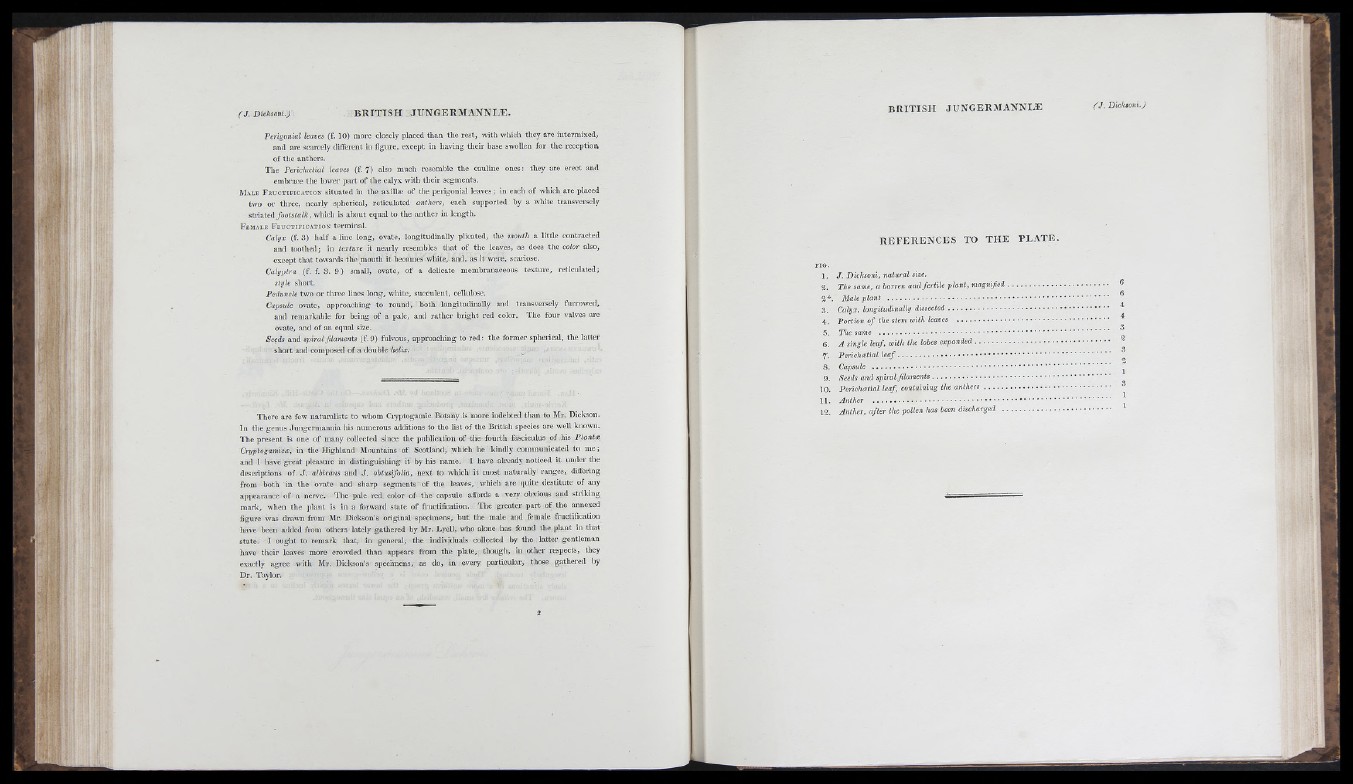
M.
Perigonial leaves (f. 10) more closely placed th an th e re s t, with which they are intermixed,
and are scareely different in figure, except in having th e ir base swollen for th e re ception
o f th e anthers.
Tlie Perichælial leaves ( f .7 ) also much resemble th e cauline ones: they are e rect and
embrace th e lower p a rt o f th e calyx with th e ir segments.
\LE F r u c t i f i c a t io n situated in th e a x illæ o f the p e r ig o n ia l le ave s ; in each o f w h ic h are placed
tw o o r thre e , n e a rly sp h e rica l, reticu late d anthers, each sup p o rte d b y a w h ite tra nsve rs e ly
s tr ia te d / o o is ia B i. w h ic h is a b o u t equal to th e a n th e r in le n g th .
F e m a l e F r u c t i f i c a t io n te rm in a l.
Calyx (f. 3 ) h a lf a line long, ovate, longitudinally plicated, tlie mouth a little contracted
and toothed; in texture it ne a rly resembles th a t of th e leaves, as does th e color also,
except th a t towai'ds th e mouth it becomes white, and, as it were, scariose.
Cahjptra (f. f. 3. 9 ) small, ovate, o f a delicate membranaceous tex tu re , reticulated;
style short.
Peduncle two o r th re e lines lo n g , white , succulent, cellulose.
Capsule ovate, approaching to round, bo th longitudinally and transi-ersely furrowed,
and remarkable for being o f a pale, and ra th e r b right red color. T h e four valves are
ovate, and o f an equal size.
Seeds and spiral filaments (f. 9) fnb'ous, approaching to red : th e form e r spherical, th e la tte r
sh o rt and composed o f a double helix.
T h e re are few na tura lists to whom Cryptogamic. B otany .is more indebted th an to Mr. Dickson.
In th e genus .Tungeraiannia his numerous additions to th e lis t of the British species are well known.
Th e p re sent is one o f many collected since the publication o f th e fo u rth fasciculus o f his Plantæ
Crtjptogamicoe, in the Highland Mountains o f Scotland, which he kinilly communicated to m e ;
and I have gre a t pleasure in distinguishing it by his name. I have already noticed i t unde r the
descrijitions o f J . albicans and J . obtusifolia, next to which it most naturally ranges, differing
from both in th e m-ate and sharp segments o f th e leaves, which a re (juite de stitute of any
appearance o f a nerve. T h e pale red, color o f th e capsule affords a very obvious and striking
m a rk , when th e p lan t is in a forward sta te o f fructification. T h e gre a te r p a rt o f th e annexed
figure was drawn from Mr. Dickson’s original specimens, b u t th e male and female fructification
have been added from others lately gathered by Mr. Lyell, who alone ha s found th e p lan t in th a t
sta te . I o u g h t to rema rk tha t, in g eneral, th e individuals collected by th e la tte r gentleman
have th e ir leaves more crowded th an appears from th e plate, thougli, in o the r respects, they
exactly agree w ith Mr. Dickson’s specimens, as do, in every pa rticu la r, those gathe red by
Dr. Taylor.
R E FER ENC E S TO TH E PLATE.
J . Dicksoni, natural size.
The same, a barren and fe r tile p la n t, :
Male p la n t ............................................................................................................................
Calyx, longitudinally d isse c ted ........................................................................................... ^
Portion o f the stem with leaves .....................................................................................
The same .................................................................................................................................. ^
A single leaf, with the lobes e xp a n d ed ............................................................................
P erichatial l e a f ........................................................................................................................
Capsule .......................................................................................................................................... ^
Seeds and spiral filam e n ts ....................................................................................................
PerichaUiul leaf, eontaimng the a n th e r s ......................................................................... ^
A nthe r .....................................................................................................................................
A nthe r, afte r the pollen has been discharged .............................................................